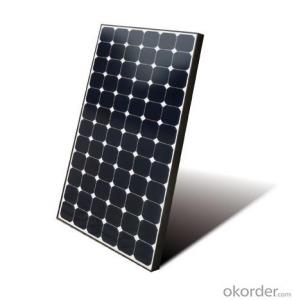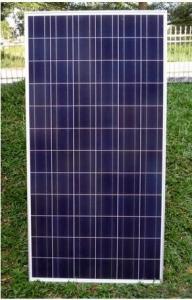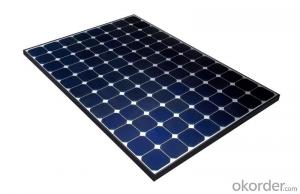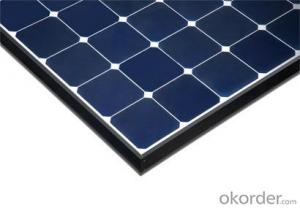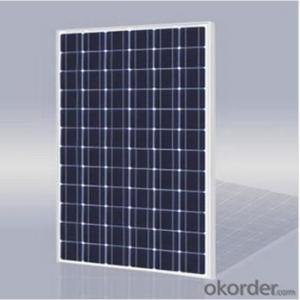Solar Energy Systems Peoria CNBM On Grid System 2000W with Certificate UL TUV CE
- Loading Port:
- Shanghai
- Payment Terms:
- TT OR LC
- Min Order Qty:
- 100 watt
- Supply Capability:
- 1000 watt/month
OKorder Service Pledge
OKorder Financial Service
You Might Also Like
Specification
CNBM On Grid System 2000W with Certificate UL TUV CE
Product description
They range from small residential and commercial rooftop systems to large utility-scale solar power stations. Unlike stand-alone power systems, a grid-connected system rarely includes an integrated battery solution, as they are still very expensive. When conditions are right, the grid-connected PV system supplies the excess power, beyond consumption by the connected load, to the utility grid.
Connection of the photovoltaic power system can be done only through an interconnection agreement between the consumer and the utility company. The agreement details the various safety standards to be followed during the connection.[4]
Systems such as Net Metering and Feed-in Tariff which are offered by some system operators, can offset a customers electricity usage costs. In some locations though, grid technologies cannot cope with distributed generation feeding into the grid, so the export of surplus electricity is not possible and that surplus is earthed.
Grid-connected PV systems are comparatively easier to install as they do not require a battery system.[1][6]
Grid interconnection of photovoltaic (PV) power generation systems has the advantage of effective utilization of generated power because there are no storage losses involved.[7]
A photovoltaic power system is carbon negative over its lifespan, as any energy produced over and above that to build the panel initially offsets the need for burning fossil fuels. Even though the sun doesn't always shine, any installation gives a reasonably predictable average reduction in carbon consumption.
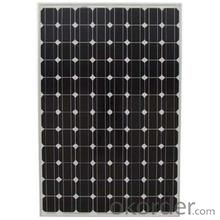
Application
Industrial
Commercial
Residential
Feature
Residential, grid-connected rooftop systems which have a capacity more than 10 kilowatts can meet the load of most consumers.[2] They can feed excess power to the grid where it is consumed by other users. The feedback is done through a meter to monitor power transferred. Photovoltaic wattage may be less than average consumption, in which case the consumer will continue to purchase grid energy, but a lesser amount than previously. If photovoltaic wattage substantially exceeds average consumption, the energy produced by the panels will be much in excess of the demand. In this case, the excess power can yield revenue by selling it to the grid. Depending on their agreement with their local grid energy company, the consumer only needs to pay the cost of electricity consumed less the value of electricity generated. This will be a negative number if more electricity is generated than consumed.[3] Additionally, in some cases, cash incentives are paid from the grid operator to the consumer.
Packaging
With carton and box
- Q: Can solar energy systems be used for powering electric vehicle solar charging stations at rest areas?
- Solar energy systems can indeed be utilized for the purpose of powering electric vehicle solar charging stations at rest areas. By installing solar panels at these locations, sunlight can be captured and converted into electricity. This generated electricity can then be employed to fuel the charging stations, offering a means for electric vehicles to charge their batteries using clean and renewable energy. This incorporation of solar charging stations presents a noteworthy opportunity to efficiently and sustainably employ solar energy, thus diminishing dependence on fossil fuels and reducing carbon emissions. Furthermore, the integration of energy storage systems, such as batteries, with these charging stations allows for the storage of surplus electricity produced during the day. This stored energy can then be utilized during the night or on cloudy days, ensuring constant availability of charging services even when sunlight is not readily available. Ultimately, the utilization of solar energy systems to power electric vehicle charging stations at rest areas proves to be a solution that is both environmentally friendly and economically feasible.
- Q: Can a solar energy system be installed on a carport or parking lot?
- Yes, a solar energy system can be installed on a carport or parking lot. In fact, carports and parking lots are ideal locations for solar panel installations as they provide ample space and can generate clean energy while also providing shade and protection for vehicles. This also allows for dual use of the space, making it a cost-effective and sustainable solution for generating renewable energy.
- Q: How can I find a reputable solar energy system installer?
- To find a reputable solar energy system installer, you can follow these steps: 1. Research and educate yourself: Begin by learning about solar energy systems, how they work, and the types of installations available. This will help you understand the basics and make informed decisions during the selection process. 2. Ask for recommendations: Reach out to friends, family, colleagues, or neighbors who have already installed solar systems. Inquire about their experience with the installer they hired, the quality of the work, and any potential issues or concerns they faced. Recommendations from trusted sources can be valuable in finding reputable installers. 3. Check credentials and certifications: Ensure that the installer you are considering has the necessary licenses, certifications, and insurance to carry out solar installations. Look for certifications from reputable organizations such as the North American Board of Certified Energy Practitioners (NABCEP) or the Solar Energy Industries Association (SEIA). 4. Research online reviews and ratings: Explore online review platforms, such as Google, Yelp, or Angie's List, to read customer reviews and ratings about different solar installers in your area. Pay attention to recurring positive or negative feedback and consider the overall reputation of the installer. 5. Obtain multiple quotes: Reach out to several solar installers and request detailed quotes for your specific project. Take note of the equipment they propose, warranties offered, pricing, and any additional services included. This will allow you to compare different installers and make an informed decision. 6. Ask for references and past projects: Request references from the installer to speak with previous customers about their experience. Inquire about the quality of work, timeliness, customer service, and any issues encountered. Additionally, ask the installer for examples of past projects they have completed to evaluate their workmanship and attention to detail. 7. Evaluate warranties and post-installation services: Inquire about the warranties provided by the installer for both the equipment and the installation work. A reputable installer will offer comprehensive warranties to ensure the longevity and performance of your solar system. Additionally, ask about any post-installation services they provide, such as maintenance, repairs, or monitoring. 8. Get multiple opinions: If you encounter any doubts or concerns during the selection process, don't hesitate to seek a second opinion from another reputable installer. This can help you gain further clarity and confidence in your decision. Remember, finding a reputable solar energy system installer is crucial for the long-term success and performance of your solar system. Take your time, do thorough research, and choose an installer that aligns with your needs, budget, and values.
- Q: Can solar energy systems be used in powering street lights?
- Yes, solar energy systems can be used in powering street lights. Solar panels can be installed on street light poles or nearby rooftops to capture sunlight and convert it into electricity. This clean and renewable energy source can then be used to power the street lights, reducing the dependence on traditional grid electricity and lowering overall energy costs. Solar-powered street lights are increasingly being adopted globally as an environmentally friendly and sustainable lighting solution.
- Q: Can solar energy systems be used for powering off-grid educational institutions?
- Yes, solar energy systems can be used for powering off-grid educational institutions. Solar panels can be installed on the roofs or grounds of the institutions to harness sunlight and convert it into electricity. This renewable energy source can provide a reliable and sustainable power supply, especially in remote areas where grid connectivity is limited or unavailable. Solar energy systems can effectively meet the energy demands of educational institutions, powering classrooms, lighting, computers, and other equipment. Additionally, it promotes environmental sustainability and reduces reliance on fossil fuels, making it a suitable option for off-grid educational institutions.
- Q: Can solar energy systems be used for emergency backup power?
- Yes, solar energy systems can be used for emergency backup power. Solar panels can generate electricity during daylight hours and store excess power in batteries for use during emergencies or when the grid goes down. This provides a reliable and sustainable source of backup power in situations where traditional power sources may not be available.
- Q: Can solar energy systems be used for powering outdoor signage or billboards?
- Yes, solar energy systems can indeed be used to power outdoor signage or billboards. Solar panels can be installed on the rooftops, nearby poles, or on the billboard structure itself to harness sunlight and convert it into electricity. This renewable energy source provides a sustainable and cost-effective solution for powering outdoor advertising, reducing reliance on traditional grid electricity and minimizing environmental impact.
- Q: Can solar energy systems be used in powering research farms or agricultural laboratories?
- Certainly, research farms and agricultural laboratories can utilize solar energy systems to power their operations. Solar energy presents a clean and renewable power source that can be harnessed through the installation of solar panels. These panels convert sunlight into electricity, which can then be utilized to operate various equipment and facilities. The electricity needs of research farms and agricultural laboratories are often substantial, encompassing lighting, heating, cooling, and the operation of agricultural machinery. By making use of solar energy systems, these facilities can reduce their dependence on fossil fuels and diminish their carbon footprint. The installation of solar energy systems can occur on building rooftops or open land adjacent to the research farm or laboratory. The amount of solar energy generated is contingent on factors such as facility location, solar panel size, and sunlight exposure. Nonetheless, advancements in solar technology have made it possible for even areas with limited sunlight to benefit from solar energy systems. Apart from their environmental friendliness, solar energy systems can also yield long-term cost savings for research farms and agricultural laboratories. Once installed, solar panels have a lifespan of 25-30 years and require minimal maintenance. This translates to significant reductions in electricity bills, particularly in rural areas where grid connectivity may be unreliable or costly. Moreover, solar energy systems can provide a dependable power source, especially during peak demand periods or power outages. By incorporating battery storage systems, surplus energy generated during the day can be stored and utilized during nighttime or cloudy days, guaranteeing a continuous power supply for research activities. In summary, solar energy systems offer a feasible and sustainable solution for powering research farms and agricultural laboratories. They boast multiple advantages, including decreased environmental impact, long-term cost savings, and a reliable power supply. As the demand for renewable energy continues to surge, the integration of solar energy systems into agricultural facilities can contribute to a greener and more sustainable future.
- Q: Can solar energy systems be used in powering recreational facilities like gyms or spas?
- Yes, solar energy systems can definitely be used to power recreational facilities like gyms or spas. Solar panels can be installed on the roofs or grounds of these facilities to convert sunlight into electricity. This renewable energy source can provide a significant portion, if not all, of the power needed to operate the facilities. Additionally, solar energy systems can help reduce the carbon footprint of these establishments and contribute to a more sustainable and environmentally friendly operation.
- Q: Can solar energy systems be used for powering electric vehicle showrooms?
- Certainly, solar energy systems have the capability to power electric vehicle showrooms. Solar energy, which is both clean and renewable, can effectively supply electricity to a wide array of applications, such as commercial buildings like showrooms. By installing solar panels on the showroom's roof or surrounding areas, the sun's energy can be converted into electricity. This generated electricity can then be utilized to operate various functions within the showroom, including lighting, air conditioning, charging stations, and other electrical equipment. This not only decreases reliance on grid electricity, but it also aids in lowering carbon emissions and promoting sustainability. Moreover, solar energy systems can offer a cost-effective solution in the long term, as they contribute to reducing or eliminating electricity bills while providing a reliable and consistent power source.
Send your message to us
Solar Energy Systems Peoria CNBM On Grid System 2000W with Certificate UL TUV CE
- Loading Port:
- Shanghai
- Payment Terms:
- TT OR LC
- Min Order Qty:
- 100 watt
- Supply Capability:
- 1000 watt/month
OKorder Service Pledge
OKorder Financial Service
Similar products
Hot products
Hot Searches
Related keywords
